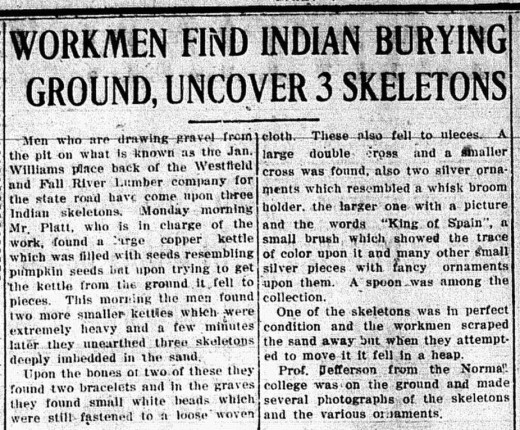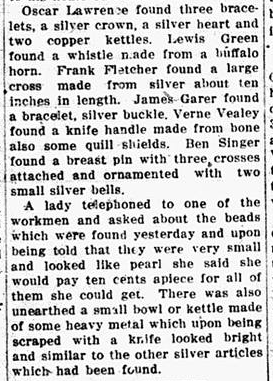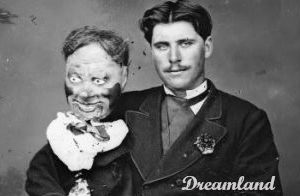The following clipping was just sent to me by a fellow named Matt Siegfried. According to him, it’s from a local paper printed June 11, 1914. The area indicated in the article, he says, is somewhere near the back of the property we new refer to as Water Street. One wonders if the photos referenced in the article still exist in the EMU archives, and whether there may be historically significant artifacts yet to be found on the site.
update: OK, according to this source, that wasn’t the only discovery in the area. There was also another significant find made 15 years previously. Here’s that story.
It’s been a long time since I’ve been in the archeology business, but, given the presence of a silver cross and crown, as well as all of the other metal items noted in the second article, I’m not quite sure that it sounds like a Native American site. I know, of course, that trade did occur between Europeans and Native Americans, but, based on the content of this second article alone, I’d be more inclined to say that these could have been the remains of an early European settlement.
update: I started searching for references to a Professor Jefferson at Normal College around 1914, and discovered an article by local historian James Mann. Here’s a clip.
…The storage room of the Ypsilanti Historical Museum may lack the splendor of King Tut’s Tomb, but therein are to be found wonderful things. Recently, as boxes of glass plate negatives were being cataloged, a collection of images originally belonging to Mark Jefferson came to light. This is an important find, as Jefferson is a major figure in the history of Eastern Michigan University and the city of Ypsilanti. His influence as a teacher is still being felt today.
Mark Jefferson was born March 1, 1863, in Melrose, Massachusetts, and at the age of seventeen entered Boston University. After three years of study he accepted a position as assistant astronomer at the National Observatory of the Republic of Argentine. Later he was sub-manager to a sugar estate, a position he accepted because of eye fatigue.
In 1901 he was appointed Head of the Department of Geography at the Michigan State Normal College, now Eastern Michigan University. He held this position until his retirement in 1939. Because of Jefferson, Michigan State Normal College became known as “The Nursery of American Geographers.”
Mark Jefferson accompanied President Wilson to the Paris Peace Conference that followed the First World War as chief cartographer. There he personally supervised the making of over 1,200 maps. The American delegation, it was noted, had the finest, most complete and accurate maps of any at the conference.
Returning to the United States after the conference, Jefferson resumed teaching at Ypsilanti, and over the years personally taught 62 different courses and some 15,000 students. He died in 1949. Jefferson once wrote “Truth is God”…
Mann goes on to discuss the fact that Jefferson was an avid photographer. So the pieces certainly fit… Looks like a trip to the Ypsilanti Historical Museum might be in order.















24 Comments
Truth is God
Mark,
I’m a graduate of the EMU Historic Preservation program and came across those articles doing research for my South Adams Street project. I plan on checking out the university archives. I think that combination of items found means that it could ONLY be a Native American site; groups of which occupied the area off and on all the way until it was settled after the American Revolution (and well after) so, of course there would have been much metal- much of it remade into ornaments. This sounds earlier than that to me given the the stone tools, but defintely fits ino the post-contact time frame- which also means that the remains could be indentified and descendants tribal bodies made aware. Matt
These news stories are known of by the State Historic Preservation Office, and part of their past approvals on the water street site (as with most projects that involve both Federal funding and significant “ground-disturbing activities”) was a notification of all native American groups with a potential interest in the area.
If i recall, SHPO’s approvals include a requirement that, should any potential remains or artifacts be noticed during work on the site, that excavation pause long enough to evaluate and document the find. (My read is that they also don’t expect anything new to be found, as the site has seen multiple geneations of development already. )
Hm, I wonder if your source is the same gentleman who checked this question with me about a week ago; I wrote about it back in 2010 for YpsiNews.com. I remember the “silver crown” detail and the feeling of being shocked when I originally read the article–that people were allowed to ransack the site with no archaeological consideration whatsoever.
I looked up the entry on my historical blog (http://ypsiarchivesdustydiary.blogspot.com/search/label/water%20street) and unfortunately I did not copy and paste the story and images in full, but linked to it; the link is now extinct. YpsiNews.com was the news blog Mr. Pierce was writing some time ago. You can see the story on the site (second column, sixth story down) in the Wayback Machine but unfortunately the link to the text is dead as well: http://web.archive.org/web/20101115192608/http://ypsinews.com/ I likely have the text on my old computer; it’s pretty balky but if there is interest I would be glad to look for it.
For Mark and everyone: if anyone has an Ypsi research question or wonders if a certain item is in the holdings of the Archives, in the basement, you can check the database online, here: http://www.ypsilantihistoricalsociety.org/ArchivesDatabasePage.html . Please note that it’s a big file and takes a minute or so to fully load; when it does, it’s easy to search. Alternatively, research questions may be sent to yhs.archives@gmail.com. If folks stop in on Saturdays, 2-5 p.m., I would be happy to help anyone with a question.
p.s. I just took a look at the chapters “The Ypsilanti Years” and “Teaching at Ypsilanti’s Normal College” in my copy of Geoffrey Martin’s book “Mark Jefferson: Geographer.” I don’t see a mention of the Water Street excavation. Jefferson seems to have been a very prolific writer of articles and textbooks; possibly a close look at his articles might bear fruit.
As an aside, in Martin’s book is a reproduction of a quatrain that students wrote about Jefferson, which was originally published in the 1906 yearbook the Aurora:
What cares he for printed pages, with their dusty lore?
To his mind, there is a volume which contains much more;
‘Tis the book great Nature opens in this world of ours;
With all her wondrous lessons in hills and streams and flowers.
For a few years I made my living as an historic archeologist, doing cultural impact studies around New York, New Jersey and Pennsylvania. During that time, we found the occasional Native American artifact, but I don’t recall having found anything that was clearly “post European contact.” For instance, we never found metal points (arrowheads) or tools. So maybe there’s some bias on my part, just because I’ve never encountered such a site. Also, I must have missed the reference to stone tools in my reading of the articles. At any rate, I wasn’t ruling out the fact that these were Native American burials. I was just saying that, given the quantity of post-contact material, it seemed strange to me. Of course, it would also seem strange for me to have found a site where early settlers were buried with their cooking pots, etc. I just wish I’d been there to do a proper excavation before people starting jumping in and filling their pockets with teeth, bracelets, etc.
I didn’t see the reference to stone tools.
Also, to Murph’s point, of all the significant archeological sites I helped to identify and record, I don’t recall one instance where development was thwarted as a result. Generally speaking, development trumps history. Construction might be delayed in some instances, as we collected data, and tried, to the best of our ability, to understand what had taken place on the site, but I think that was the extent of it… That was one of the worst parts of the job.
Interesting.
Someone put this up at Water Street a couple weeks ago:
http://art-hut.org/2014/03/30/550/
Building on Mark’s expert observations, the list of artifacts is a little odd, isn’t it? Even at the time, and speaking as a layman, the collection, and some of the described design motifs, didn’t seem paradigmatic of a burial site for any of the Native American groups that lived in or traversed this area–based on my limited reading on the subject (I would love to be corrected in the interest of learning more). Extensive trade routes existed, of course. Some artifacts seem as though they may be of native origin; others seem sort of odd. Perhaps someone knowledgeable can assess them more easily if the artifacts are sifted out of the article:
three skeletons
large copper kettle filled with seeds resembling pumpkin seeds
two small, extremely heavy kettles
two bracelets
small white beads still fastened to a loose woven cloth
large double cross*
smaller cross
two silver ornaments which resembled a whisk broom holder, larger one with a picture and the words “King of Spain”
small brush which showed a trace of color upon it
many other small silver pieces with fancy ornaments upon them, including a spoon
(second article)
three bracelets
silver crown
silver heart
two copper kettles
buffalo horn whistle
ten-inch silver cross
bracelet
silver buckle
bone knife handle
quill shields
breast pin with three crosses attached, ornamented with two small silver bells
small bowl or kettle made of heavy metal; when scraped, resembled silver
*Is this meant to refer to the Cross of Lorraine? Wiki: http://en.wikipedia.org/wiki/Cross_of_Lorraine
Excerpt: “French Jesuit missionaries and settlers to the New World carried the Cross of Lorraine c. 1750-1810. The symbol was said to have helped the missionaries to convert the native peoples they encountered, because the two armed cross resembled existing local imagery.”
I was thinking French missionaries as well. This is a great thread. Thank you, Laura, and everyone else.
I’ve worked on several Native archaeological sites on the Huron, especially in the Metroparks south of Ypsilanti, and this collection sounds exactly like a (very rich) late-post contact site. It should also be underlined that Christians don’t get buried with grave goods, so being buried with multiple items (especially multiple burials of multiple items) is a strong indication of Native burial. The bluff opposite of the cemetery on the west bank of the Huron had numerous burial tumuli recorded roughly from Catherine to Pearl, especially the area where the Gilbert Residence now is. This cemetery would have been in direct site of the mounds on the opposite bank attributed in the 19th c to the Wyandottes. Taken with the trails, large farming area where Ford Lake is, the Mounds by Concordia all make for an intriguing picture of extensive use of this area of the Huron. I’ve worked in the State Historic Preservation Office on the history side- I’ll email Dean on the archaeological side and see what information the State may have.
It should also be noted, that if anyone at the time these were uncovered thought the burials might have been white folks, including earlier settlers and traders, they would not have been looted. They would have been venerated like the pioneer cemetery at Carpenters Corners found and rededicated around the same time.
We’re assuming, of course, that these individuals were buried “with” these items. It’s conceivable this was not the case. Without having been there, and without the photos, it’s near impossible to say for certain what they may have found.
I’m sure the Water Street Dollar Store could hang a plaque and make it all OK.
It might be a stretch, given that the name Lawrence is a common one, but I’ve heard that the family of local landlord Joe Lawrence goes back to almost the very beginning in Ypsi, and I’m wondering if the Oscar Lawrence mentioned in the second article could be a relative. If so, I also wonder if any of the items mentioned might be in Joe’s possession.
“Oscar Lawrence found three bracelets, a silver crown, a sliver heart and two copper kettles.”
Just wrote Stacy at the archaeological department of SHPO (she did her thesis on an archaeological investigation on the area of the Worden house just opposite this site) with the articles and will let all know what she says.
Oscar Romaine Lawrence was the great-grandson of mid-19th-century settlers in Augusta township. There is more census and other info but considering that there may be a living relative, it seems as though it’s the relative’s story to tell.
Neat thread, thanks to everyone for sharing. I would love to see if our community could track down some of the notable items and preserve them.
If Joe has them I doubt he’ll tell us.
Obviously, this explains the problems with Water Street.
I found a carved animal bone that has a silver clip on it. I found it metal detecting in frog island park. The small clip is silver, it’s a circle with a line through the center. The overall look is like and shape is that of a feather that’s about 5″ long. On the flat areas of the bone it has notches carved into it. I’m was hoping someone from this thread will contact me ASAP as to I’m only here until nov 1st Please call me at 734 968 7339
I also found a 1893 Arura Normal School of Mich YearBook in an old farmhouse that I am donating to EMU Historical Society. I was told it was their very first year the made one. I’m very interested in preserving history. I believe my above mentioned carved feather made of animal bone is very old and could date to the 16th or 17th century. I would also considering donating it as well once it’s been authenticated.
To the author, thanks for the post !
I have been researching these type antiquities for a very long time and I am to far for a direct examination till next year.
I am hoping one of you locals can check with the family’s descendants involved to get a few high resolution photos of anything found in these digs.
If I must tease you a bit, I suspect these are as old as 1700 to 2800 years old.
I am confused a bit on any of them being silver artifacts and that makes them a must see.
I should be able to tell a strange but enlightening story if I can see them in some way via photo. Any of you locals feel like doing some research ?
Most especially if there is writing or symbols on any of the pieces.
I am not interested in the find outside of some missing historical facts.
There is a story there that must be told.
One Trackback
[…] As I mentioned a few days ago, two articles were recently brought to my attention (one from 1901, and the other from 1914) about the discovery of what appeared to be Native American remains on the property in downtown Ypsilanti we today call Water Street. Well, I followed up with the fellow who sent these articles to me, a local historian by the name of Matthew Siegfried, in hopes of learning more about Ypsilanti’s Native American past, and what was found on the Water Street site 100 years ago. What follows is our discussion. […]